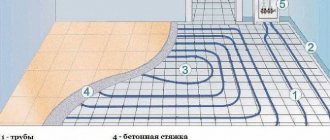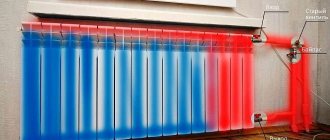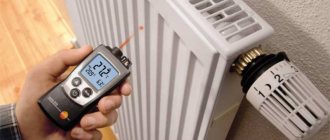Battery defrosting is a term used to describe the freezing of water in the pipes and radiators of the heating system. This threatens not only a decrease in room temperature, deformation and cracks in radiators and pipes, but also a catastrophe associated with rupture of radiators. Most often, owners of private houses face this problem. However, residents of apartment buildings with centralized heating may also face this situation. To protect yourself and your apartment, follow these recommendations.
Selection of radiators
The material from which batteries are made matters a lot. Thus, cast iron batteries are considered the most durable; they are installed in old-type apartment buildings. However, other materials are used during this process. Plastic is considered the optimal alternative to cast iron - it does not burst when defrosted and is less susceptible to corrosion. Copper and steel pipes and radiators are subject to greater stress, while aluminum is considered the least durable.
At what temperature can a heating system freeze?
the phenomenon is very unpleasant; in cases of extremely low ambient temperatures, it may well be qualified as a local emergency of a man-made nature. Therefore, this phenomenon must be taken seriously.
Exotic ways.
The imagination of folk craftsmen is truly inexhaustible. And everyone creates to the best of their strength and capabilities. Nevertheless, these ways to avoid heating freezing have a right to life.
For example, use machine oil instead of antifreeze. Well, he just has a lot of this oil. It doesn’t freeze, it just thickens. So what if it's a fire hazard? This has never frightened our people.
Or a safer way (how to say...). Build the heating element into the heating radiator; the threads match. So what if it upsets the circulation and violates all electrical safety rules. Does it work? Works. Just be careful and think before you act.
In general, summing up, I will repeat again: a reasonable combination of all or some methods of not freezing the heating system, excluding antifreeze, of course, allows you to increase the reliability of the entire system. (Yeah, walling up a stainless steel tank with a built-in heating element into a heat shield or gluing an infrared film heated floor to a heating radiator is a joke).
Additional heat source.
This method will also work only in heating systems with forced circulation. Actually, you don’t need anything for this. You need a backup or additional heat source in the house and a constantly running circulation pump in the heating system. By heat source I mean a stove, fireplace, convector, electric or chimney, electric heated floors. The heating system itself will select part of the heat for its operation, distributing this heat to the rooms of the house adjacent to the heat source. But make no mistake, it will not be able to heat the house by transferring this energy, the heat exchange is not the same. But it won't freeze.
Freezing point of water - interesting properties and values
Pure water is considered the best liquid that perfectly cleanses and moisturizes the body. The human body is made up of about 70% water.
If you experience fatigue, drowsiness or lethargy, it is recommended to drink one glass of warm water. According to the results of the experiment, a person should drink about 30 ml of water per kilogram of body weight. Therefore, if your weight is 70 kg, then it is recommended to consume 2.1 liters of water every day. To satisfy the body's fluid needs, it is recommended to drink at least 1.5 liters of water daily; you can drink half a glass of water every 40-50 minutes.
Water has many beneficial properties and without it life on Earth is impossible. Everyone knows that for water to freeze, the freezing temperature must be 0 degrees Celsius, but this is the case under normal natural conditions.
It is worth noting that the pressure in different parts of the globe differs significantly, so the freezing point of water depends on a certain pressure indicator.
It is important to understand the fact that the higher the pressure in the environment, the higher the freezing temperature, or vice versa, the lower the pressure in the natural environment, the lower the crystallization temperature.
Freezing temperature of water in oceans and seas
Remember to consider the presence of molecules and impurities in the water. They greatly influence the freezing point of water. For example, salt water can freeze at very low temperatures (about -2 degrees Celsius).
If you take absolutely pure water, it may not even freeze at a temperature of -70 degrees Celsius. Fish blood usually freezes at -1°C. Many scientists have wondered how fish manage to stay warm when temperatures are too low. It turns out that there are species of fish that are capable of producing proteins in the pancreas. They are absorbed by the blood and do not allow the crystallization process to begin.
See also - Temperature of the Sun in degrees Celsius - interesting facts about the Sun
Interesting properties and meanings of water
- Distilled water is an excellent dielectric and is almost incapable of conducting current.
- It expands when it freezes and evaporates.
- The only substance that manages to be in three states of aggregation at once.
- Capable of dissolving almost all substances on Earth.
- Glaciers contain about 2/3 of the world's total fresh water.
- It is generally accepted that the freezing point of fresh water is 0 degrees Celsius, and sea water freezes at a temperature of -1.8 ° C.
Timely replacement or cleaning
Any type of radiator, even the most durable, has a service life. In most older apartment buildings, batteries last beyond their useful life. This threatens the formation of blockages inside the system, a large amount of scale or the accumulation of rust. It is important to follow the recommendations for the service life of radiators. A budget solution could be to have the batteries removed and cleaned by a specialist in the summer.
How is it prohibited to heat process pipelines - dangerous methods
When we want to warm a pipe from ice ourselves, we should know in what way it is prohibited to warm process pipelines. A prohibited way to heat pipes is to use an open fire. To heat ice, use only hot water, firewood or sand at high temperatures.
Fire should not be used, as a sudden change in temperature occurs. The pipe may simply burst. Metal pipes will still withstand this heating method. But polypropylene or metal-plastic pipes will burst.
This could result in a fire and your home catching fire. Not to mention the pipes themselves. Take into account all safety measures when heating the pipeline and then you will be able to remove ice from the pipes without incident.
Interaction with neighbors
An important point in the proper functioning of the heating system and the prevention of its defrosting is informing neighbors about possible problems, as well as jointly taking action in case of trouble. During the heating season, pay special attention to elderly neighbors. Be aware of empty apartments and have contact with their owners in case of trouble.
Treat the condition of the heating system elements of your home with care and responsibility. Try to eliminate all malfunctions in the summer, when the system is not filled with coolant. Be aware of your outdoor and basement heating system and make your neighbors aware of possible hazards. Be carefull. Warmth and winter comfort!
How the heating system in my house froze for the first time
After reconstructing the house and connecting gas, I chose a Baxi wall-mounted gas boiler as the heating system, installed in the kitchen with Kermi steel radiators. Heating pipes are polypropylene. I have tile floors in the kitchen, bathroom and hallway, and I installed electric underfloor heating for foot comfort.
We now use the house as a summer cottage, year-round with almost weekly visits. When we are at home, we set the temperature in the whole house to 21 degrees, and when we leave for the city, our temperature is somewhere around 16-17 degrees.
It makes no sense to keep it lower if you come to the house regularly almost every week. However, even maintaining +16 degrees in the house allows you to save on heating.
The temperature in the house is controlled using the GSM alarm "Xital 4T"
I relaxed after that, as there was no reason to worry. But in vain.
Because our weather can present the most unexpected surprises.
The air temperature outside at night dropped from -8 degrees to -27, i.e. almost 20 degrees!
I assumed that somewhere I had just grabbed a pipe. Since the boiler was still working, due to the heating of other rooms, the temperature in the living room, closet and hallway remained about 10 degrees.
When I arrived at the house over the weekend, I immediately found the place where my heating pipes froze (marked with a red arrow)
At this point there is a junction between the log house and the frame extension. The whole point turned out to be that my workers messed up by poorly insulating the joint there. My pipes go in the wall behind the clapboard. I removed one of the boards to get to the pipes. But no matter how hard I tried, I could not warm up this part of the pipe. He aimed the heat gun and left it overnight. But in vain. All that remained was to wait for warm weather.
By the way, this incident helped us prepare for an emergency. We took out our old electric convectors, which served us even before we installed gas heating. Washed them. We have 5 of them in total. 2 pieces served us for temporary heating. At the same time, we checked everything for functionality. Now we have all our convectors wrapped in film, clean, ready for “any fire” emergency.
The pipes warmed up only on March 13, when the outside air temperature rose to 1.5 degrees
By the way, my system is based on polypropylene pipes, which withstood such freezing, since they can expand in such cases.
If the system had been made of metal-plastic, it would have been cracked and I would have had to undergo some serious repairs.
Such was the case, after which we had to re-insulate this place in the house and monitor the temperature parameters in severe frosts. I was lucky and escaped with little blood.
Good lesson! If possible, I will check the house using a thermal imager.
The forum was created for beginners and experienced plumbers, welders, mechanics, electricians and construction workers. Share your experience and receive competent answers from specialists.
Quick search
Forums: Topics:
Heating system defrost temperature
Need advice from experienced people. Tell me at what temperature the heating system actually defrosts. Water data: solid fuel boiler, about 400 liters of water in the system, forced circulation, radiators not like at home, but like in industrial premises - thick in the form of pipes. Room about 200 sq.m. with large heat losses (such as a hangar (garage, generally industrial premises). It just happened that during the holidays the stoker (whose task was not to defrost the system) defrosted this very system. Moreover, last year on the New Year holidays the frosts were higher, the system under my control, it was always in a heated state, and there were no problems. Today, the remaining water was drained from the defrosted system (about 150 liters came out, while about 400 were poured in). The stoker, of course, beats himself in the chest with his heel and assures that everything worked , and coal was thrown in at least 2 times (or even 3 a day). Tell me, in your opinion, in order to allow such a system to defrost, how long should the boiler not be heated? And also another question - at the moment, about 150 liters out of 400 have been drained, i.e. That is, it turns out that about 250 liters are left in the system. No pipe ruptures were detected by eye. What is the probability of a pipe rupture from already frozen water, provided that visually all the pipes are intact? Thank you in advance. I will try to answer the questions quickly - but you understand - now the heating needs to be restored - it is not always possible to respond promptly.
Water expands most at -5 degrees Celsius; at temperatures below, the expansion is negligible.
Don't think that others don't think.
Defrosting pipes
If the heating pipes are frozen, they must be defrosted as soon as possible. Of course, the best thing to do is to entrust this to a specialist. However, it is not always possible to invite him. In this case, you should take up defrosting yourself, sequentially performing the following steps:
- it is necessary to open the tap that is located closest to the place where the ice plug forms.
- gradually move further and further, opening more distant taps.
- Defrosting should be done at a relatively low constant temperature (you should calmly keep your hand on the pipe).
- overheating of a pipe can have a detrimental effect on it - it can simply rupture under the influence of excessive pressure that has arisen in the pipe.
Perhaps the simplest and safest method for defrosting a heating system is to simply turn on the heating system. Gradually heating up, it will contribute to the rapid defrosting of the frozen section.
Pouring hot water over a pipe is an easy way to defrost it.
If the heating pipe that runs directly in the house or basement is frozen, you can use the following method to solve the problem. The “affected” area is wrapped tightly with cloth, and moderately hot water is carefully poured onto it. Of course, a container should be placed below into which this water will drain.
Another solution to the problem that the heating system has defrosted is to use an electric sheet (blanket) or an electric heating pad. It is wrapped around a pipe, connected to the power supply and gradually heated. In this case, you should control the heating level, gradually increasing it. If the frozen piece of pipe is very long, its heating element should be carefully moved along the plug.
A fairly effective way to deal with frozen areas is to expose them to a stream of warm air created by a small fan heater or a regular hairdryer. However, this method is only suitable for small frozen areas.
Another option for dealing with ice jams is to use conventional lamps with heat-reflecting reflectors. But this method is only suitable for small areas of frozen pipes.
Anti-icing and network heating systems
There is one more unfavorable nuance: pipes burst, which subsequently washes away the house structure with water, and the foundation is eroded. Next, you will need to carry out serious repairs, which will entail impressive amounts of costs. To avoid such an unpleasant moment, you can use a system of anti-icing and network heating of pipes.
To ensure continuous external defrosting of the heating system, a heating device such as a resistive series cable is used.
This system is good to use for pipes of considerable length. If compact heating is required, a self-regulating cable can be used.
To ensure anti-icing in drinking water pipes, a cable of this type is laid directly inside the pipes.











